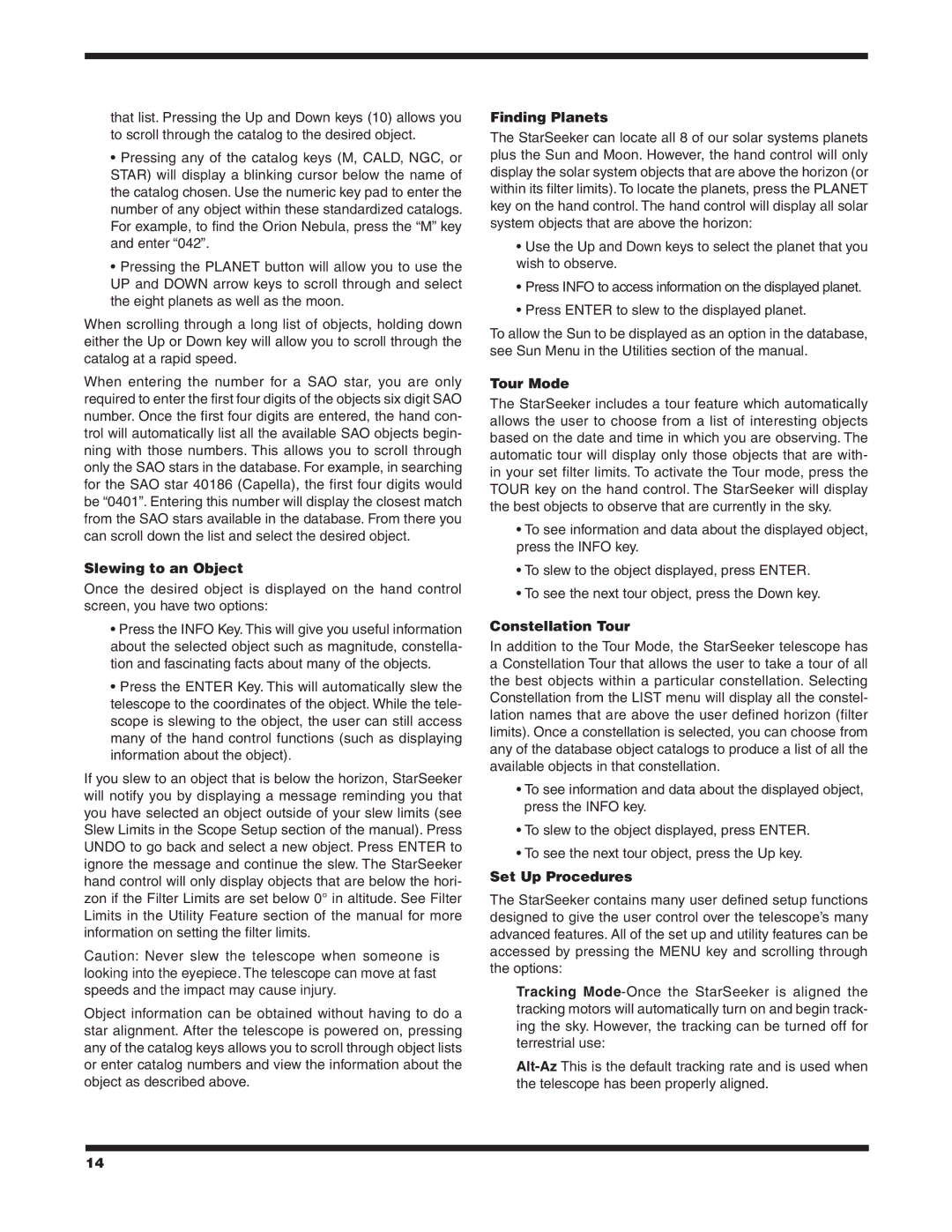that list. Pressing the Up and Down keys (10) allows you to scroll through the catalog to the desired object.
•Pressing any of the catalog keys (M, CALD, NGC, or
STAR) will display a blinking cursor below the name of the catalog chosen. Use the numeric key pad to enter the number of any object within these standardized catalogs. For example, to find the Orion Nebula, press the “M” key and enter “042”.
•Pressing the PLANET button will allow you to use the
UP and DOWN arrow keys to scroll through and select the eight planets as well as the moon.
When scrolling through a long list of objects, holding down either the Up or Down key will allow you to scroll through the catalog at a rapid speed.
When entering the number for a SAO star, you are only required to enter the first four digits of the objects six digit SAO number. Once the first four digits are entered, the hand con- trol will automatically list all the available SAO objects begin- ning with those numbers. This allows you to scroll through only the SAO stars in the database. For example, in searching for the SAO star 40186 (Capella), the first four digits would be “0401”. Entering this number will display the closest match from the SAO stars available in the database. From there you can scroll down the list and select the desired object.
Slewing to an Object
Once the desired object is displayed on the hand control screen, you have two options:
•Press the INFO Key. This will give you useful information about the selected object such as magnitude, constella- tion and fascinating facts about many of the objects.
•Press the ENTER Key. This will automatically slew the telescope to the coordinates of the object. While the tele- scope is slewing to the object, the user can still access many of the hand control functions (such as displaying information about the object).
If you slew to an object that is below the horizon, StarSeeker will notify you by displaying a message reminding you that you have selected an object outside of your slew limits (see Slew Limits in the Scope Setup section of the manual). Press UNDO to go back and select a new object. Press ENTER to ignore the message and continue the slew. The StarSeeker hand control will only display objects that are below the hori- zon if the Filter Limits are set below 0° in altitude. See Filter Limits in the Utility Feature section of the manual for more information on setting the filter limits.
Caution: Never slew the telescope when someone is looking into the eyepiece. The telescope can move at fast speeds and the impact may cause injury.
Object information can be obtained without having to do a star alignment. After the telescope is powered on, pressing any of the catalog keys allows you to scroll through object lists or enter catalog numbers and view the information about the object as described above.
Finding Planets
The StarSeeker can locate all 8 of our solar systems planets plus the Sun and Moon. However, the hand control will only display the solar system objects that are above the horizon (or within its filter limits). To locate the planets, press the PLANET key on the hand control. The hand control will display all solar system objects that are above the horizon:
•Use the Up and Down keys to select the planet that you wish to observe.
•Press INFO to access information on the displayed planet.
•Press ENTER to slew to the displayed planet.
To allow the Sun to be displayed as an option in the database, see Sun Menu in the Utilities section of the manual.
Tour Mode
The StarSeeker includes a tour feature which automatically allows the user to choose from a list of interesting objects based on the date and time in which you are observing. The automatic tour will display only those objects that are with- in your set filter limits. To activate the Tour mode, press the TOUR key on the hand control. The StarSeeker will display the best objects to observe that are currently in the sky.
•To see information and data about the displayed object, press the INFO key.
•To slew to the object displayed, press ENTER.
•To see the next tour object, press the Down key.
Constellation Tour
In addition to the Tour Mode, the StarSeeker telescope has a Constellation Tour that allows the user to take a tour of all the best objects within a particular constellation. Selecting Constellation from the LIST menu will display all the constel- lation names that are above the user defined horizon (filter limits). Once a constellation is selected, you can choose from any of the database object catalogs to produce a list of all the available objects in that constellation.
•To see information and data about the displayed object, press the INFO key.
•To slew to the object displayed, press ENTER.
•To see the next tour object, press the Up key.
Set Up Procedures
The StarSeeker contains many user defined setup functions designed to give the user control over the telescope’s many advanced features. All of the set up and utility features can be accessed by pressing the MENU key and scrolling through the options:
Tracking Mode-Once the StarSeeker is aligned the tracking motors will automatically turn on and begin track- ing the sky. However, the tracking can be turned off for terrestrial use:
Alt-AzThis is the default tracking rate and is used when the telescope has been properly aligned.

